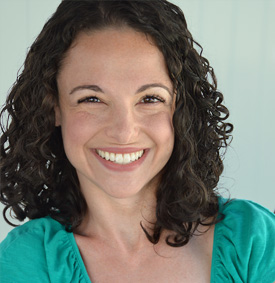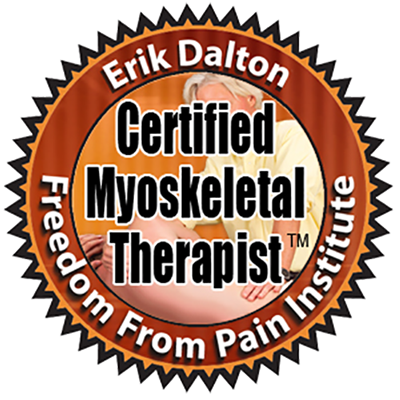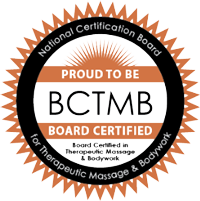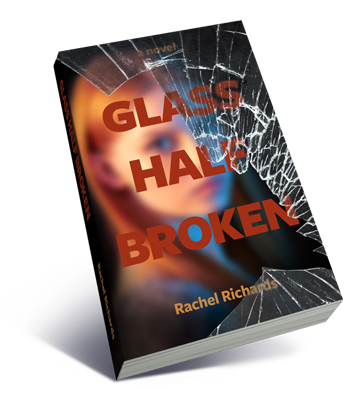News: December 2012
Stop blaming your muscles!
 There are many myths surrounding neck and back pain. I've taken five of the most common myths and will debunk them one newsletter at a time. My hope is that this information will offer you new insight into the actual causes of and best treatment approaches for your own pain.
There are many myths surrounding neck and back pain. I've taken five of the most common myths and will debunk them one newsletter at a time. My hope is that this information will offer you new insight into the actual causes of and best treatment approaches for your own pain.
Common myth #1: Most chronic pain and injuries are caused by excessive muscle tension.
Although muscle tension usually plays a part in chronic pain, it is most often only a very small part. More importantly, muscle tension is rarely the cause of the pain or injury itself, but rather a response to it. A muscle spasm, for instance, is not an injury, as many believe, but rather a secondary protective mechanism to splint the actual injury and prevent it from getting worse. If you go to see your doctor because you have terrible pain in your neck or back, for example, and he or she tells you you have a muscle spasm and prescribes pain killers, that's essentially not much help to you. The pills may take the edge off the pain for a little while, but if you don't know what caused the muscles to spasm in the first place, you can't get to the root of the problem and will likely continue to experience pain and even more spasms.
That's not to say that muscle injuries are not common. People get muscle strains and tears all the time, but they do not lead to chronic pain. This is because muscles have excellent blood supply, allowing them to heal quickly. If you have a pain in your low back one day and it's gone the next, you most likely injured your muscle. If your low back pain is still pestering you weeks, months, or even years later, you are not dealing with an injury to muscle, but rather to other structures like ligaments, joints, tendons, and fascia. (Click here to learn about fascia!) These structures are more avascular. That is, they don't have a very good blood supply and therefore take much longer to heal, if at all. If you look at the muscle chart above, you'll notice that the muscles are red, indicating plenty of vascularity, while other structures are white, representing lack of blood.
Injured tendons, ligaments, and joints are most often the cause of chronic pain. Ligaments are usually the culprits of chronic neck and low back pain. Because you feel pain in an area, the surrounding muscles may tighten in response, leading you to think that the problem is muscular. When ligaments are injured, adhesive scar tissue is laid down to bandage and immobilize the area. Ideally, tissue fibers should slide freely on each other. The collagen fibers of scar tissue, however, are not laid down in a nice, neat, parallel formation, but rather form a random, messy patch that limits mobility. When you move, the scar tissue may tear, leading to inflammation and then more scar tissue. And here's where the chronic pain cycle is established. Chronic, adhesive scar tissue is painful and often benefits from specific massage therapy techniques used to break up scar tissue and promote blood flow to the injured structures. This helps to form a more functional scar and sets the stage for healthier healing, increased mobility, and less pain.
Muscle tension is usually a side effect, not the source of chronic pain. If you've had pain for weeks or months, you can be pretty sure you're dealing with a ligament, tendon, joint, or fascial injury. Don't wait and allow the pain cycle to perpetuate. Rather, seek the help of a skilled massage therapist who can help put an end to the pain before it becomes a chronic pain in the neck!
(Tune in next month for common myth #2!)
Source: Dr. Ben Benjamin, World Massage Conference
An active body = a bigger brain?
According to a recent study, that might just be the case. Physical exercise several times per week may actually prevent parts of the brain from shrinking as you age - namely, the areas of the brain linked to thinking and memory. In fact, exercise was shown to be significantly more effective at preserving the integrity of the brain than mental or social activities.
In the study, 600 people ages 70+ provided detailed information on their physical, mental, and social activity. Three years later, the same subjects were given brain imaging scans. The results showed that those who were physically active several times a week had less shrinkage and damage to their brain's white matter, which is analogous to the network cables that connect computers and provide communication. These findings remained significant even after the researchers accounted for variables such as age, health, and social status.
So exercise regularly and keep it up as you age, and you may prolong the healthy life of both your body and your brain!
Source: New York Times
What's new with me ...
I can't believe I'm already 6 months pregnant! Jesse and I enjoyed learning a tremendous amount at a childbirth class held at the studio where I take prenatal yoga. I especially liked the part where the dads-to-be practiced massaging their pregnant wives :)
Jesse and I have our baby names narrowed down to 35! (Yes, we have a spreadsheet and started out with about 100 names. Don't judge.)

Call or text me today
917-359-8641
I'd be happy to answer
any questions you have!
Massage@Rachel-Richards.com
Subscribe to my Youtube channel!
Did you know?





